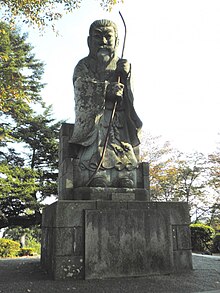Emperor Keitai
| Keitai | |
|---|---|
| Emperor of Japan | |
 |
|
| Reign | 3 March, 507 – 10 March, 531 |
| Predecessor | Buretsu |
| Successor | Ankan |
| Born | 450 |
| Died | 531 (aged 81) |
| Burial | Mishima no Akinu no misasagi (Osaka) |
Emperor Keitai (継体天皇 Keitai-tennō?), also known as Keitai-okimi, was the 26th emperor of Japan, according to the traditional order of succession.
No firm dates can be assigned to this emperor's life or reign, but he is conventionally considered to have reigned from 507 to 531.
Keitai is considered to have ruled the country during the early-6th century, but there is a paucity of information about him. There is insufficient material available for further verification and study. Significant differences exist in the records of the Kojiki and the Nihon Shoki.
Kojiki puts this emperor's birth year at 485; and his date of death is said to have been April 9, 527. In the extant account, he is called Ōdo no Mikoto (袁本杼命).
Nihon Shoki gives his birth year at 450; and he is said to have died on February 7, 531 or 534. In this historical record, he is said to have been called Ōdo no Kimi (男大迹王) and Hikofuto no Mikoto (彦太尊). Also, records identify him as Wo Ofu Ato-no-Hiko Fudo no Mikoto.
In other historical records, he is said to have originally been King of Koshi, a smaller tribal entity, apparently in northern parts of central Japan, perhaps as far as the coast of Sea of Japan. Some modern reference works of history call Keitai simply King Ohoto of Koshi.
Keitai's contemporary title would not have been tennō, as most historians believe this title was not introduced until the reigns of Emperor Tenmu and Empress Jitō. Rather, it was presumably Sumeramikoto or Amenoshita Shiroshimesu Ōkimi (治天下大王), meaning "the great king who rules all under heaven." Alternatively, Keitai might have been referred to as (ヤマト大王/大君) or the "Great King of Yamato."
...
Wikipedia
